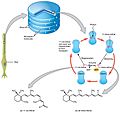Photoreceptor cell facts for kids
Quick facts for kids Photoreceptor cell |
|
|---|---|
 |
|
| Scientific classification |
A photoreceptor cell is a special type of cell. It is found in your retina, which is at the back of your eye. These cells are amazing because they can turn light into signals. Your brain can then understand these signals as images. Think of them like tiny light sensors in your eyes! They help you see the world around you.
Photoreceptor cells work by absorbing tiny packets of light called photons. When a photon hits a special protein in the cell, it creates an electrical signal. This signal then travels to your brain. This process is called visual phototransduction.
There are three main types of photoreceptor cells in human eyes. The two most well-known are rods and cones. These two types help you see everything. A third type, called intrinsically photosensitive retinal ganglion cells, was found in the 1990s. These cells do not help you see directly. Instead, they help control your sleep-wake cycle and how your pupils react to light.
Contents
How Rods and Cones Help You See
Rods and cones are both important for your vision. But they work best in different light conditions. They also help you see different things.
Rods: Seeing in the Dark
Rods are very sensitive to light. They can even be triggered by a single photon! This means rods are super helpful for seeing in very dim light. When it is almost dark, your vision relies mostly on your rod cells. This is why you cannot see colors well in the dark.
Cones: Seeing Color and Detail
Cones need much brighter light to work. They are responsible for your color vision. Humans have three different types of cone cells. Each type responds best to different colors of light. These are:
- S-cones: Respond best to short wavelengths (like blue light).
- M-cones: Respond best to medium wavelengths (like green light).
- L-cones: Respond best to long wavelengths (like red light).
Your brain combines the signals from these three types of cones. This allows you to see all the different colors in the world. Since cones need more light, you cannot see colors when it is very dark. Only your rods are active then.
The human retina has about 120 million rod cells. It also has about 6 million cone cells. The number of rods and cones can be different in other animals. This depends on if an animal is mostly active during the day or night. For example, owls that hunt at night have many more rods.
Arrangement of Photoreceptors
Photoreceptor cells are usually arranged in a pattern. This pattern is like an irregular but almost hexagonal grid. This arrangement is known as the retinal mosaic. It helps your eye capture light efficiently.
Images for kids
See also
 In Spanish: Fotorreceptor para niños
In Spanish: Fotorreceptor para niños



